
 |

|
|
|
|
Height: 5' 10½" (1,79 m) Weight: 150 pnds Eyes: blue Hair: blonde Marriages: (1) Eileen Palmer, actress (May 1 or 2. 1940 - Sep 1944, divorced) (2) (2) Alice Joanna Reinheart, actress (Dec 11. 1945 - Nov 1961, divorced) (3) Ruth Ann Mills (Oct 18. 1963 - May 26. 1967, divorced) (4) Joan Lenore Hertz (Jul 17. 1980 - Dec 19. 2003, his death) Siblings: Walter (Jan 26. 1911 - Aug 1. 1982), Stella (Jan 9. 1923 - Sep 4. 1999). Charles Walter Henning (half-brother) |
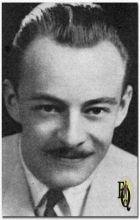 |
|
Born in Balham, London, England, as Lester Tremayne Henning on April 16. 1913 to an American electrical engineer/carpenter (of German descent) Walter Carl Christian Henning and a British actress Dorothy Alice Tremayne Gwilliam. Ever since he was a child, his family in England made countless career capers. His mother was a movie star (silent movie), his father a bass singer, his grandmother an opera singer, his uncle a film producer and director, and his brother, an aunt and a cousin all played in stock and films. Every morning, after the dinner menu was settled with the cook, his mother, Dolly Tremayne took her fat little three-year-old Les, and her five-year-old, Wally, and departed for the studio where greasepaint was their "Mother Goose". Les himself began film work when he was 4 years old under direction of his uncle Alex Butler, producer and director. The same age he had when his family moved to Chicago. It was there in Oklahoma, at ten years old, where he got his first memory of radio, where his father turned the kitchen into a concert hall. Using the table as a stage, he built their first radio. Nothing more than a bunch of wires twisted around two oatmeal boxes but it worked. One wire was called the cat whisker. His father connected it to a crystal and after some repositioning, music came out of headphones that he had placed in a glass bowl on the table. Those served as amplifiers and so we could listen to music as well as voices. He had no idea that one day his voice would also be heard like this in other houses around the country. At the same age, he worried a lot. What was his mother to do if there were another war and he, his brother, and father were killed? He worried about the family finances and about a college education for his baby sister, who was then nine months old. To save the world he decide he would become a preacher. In 1923, the family moved back
to Chicago, where Les finished grammar school. Star boy soprano of the
school he was considered pretty smart by his teachers because he had skipped
several grades. After a group of bullies beat him he disguised his British
accent while growing up. For his vocal ability he was awarded a high school scholarship. The fourteen-year-old composed his face into serious, experienced lines and applied for the position of secretary in a doctor's office. He worked for the doctor for a year and a half, during which time he cultivated a mustache and a secret ambition to become a surgeon. The doctor relocated, the Depression began, and Les found himself unemployed. Like a homing pigeon, he made his way to the Little
Theatre and took on various roles from stage manager to call boy, without
pay. Selling vacuum cleaners in the Chicago area, he also served as a
district manager for a publishing company. Out of passion rather than
financial gain, he collaborated with two marionette theaters, participated
in community productions and religious pageants, acted at an abandoned stone
quarry near Surrey, Wisconsin, and took on the two leading roles in Lorado
Taft's Gates of Paradise
(1932). He went to work in a chocolate factory, where he piled hundred-pound crates of hot chocolate syrup in ten high columns and learned about women from the chocolate dippers. After straining his appendix he got himself a bicycle and a job as a bellhop and busboy in a country club. "That's where I learned to humble myself." Nearly a year after Les quit the movie racket school one of Tremayne's former movie school pupils phoned him. He offered to join him for a tryout to do some broadcasting on WCFL. He was accepted without audition and made his first appearance on his nineteenth birthday on the humorous Night Court program (1932) ***. For the first eight months he received no pay for his radio work. Evenings that he didn't appear on the radio, he studied shorthand and commercial art at night school. In the space of six months, he worked for NBC and CBS and the Mutual networks. Dozens of local stations spotted him on twice that many programs. He was director, announcer, narrator, actor. Life now assumed a more carefree aspect. He made his first appearance on a network show in Campana's Fu Manchu (1931), bought his first dress suit, and received five dollars for a personal appearance in Milwaukee. At last, at a salary, he was engaged as announcer on the Bundeson show on WLS, played the love interest in The Romance of Helen Trent (CBS, 1933). He was heard in National Barn Dance, Homemakers Theater, the Old Apothecary, The Heart to Heart Club and many more. In 1934 he bought a '29 Studebaker and then he found the girl. He met her when he was making a personal appearance with a road show in Indiana. Romance shuttled between Chicago and Indiana on the gallant tires of the '29 Studebaker. One rainy Friday morning in April '35 he had the feeling Anne wanted to see him. He drove 500 miles and took the porch two steps at a time. When the door opened there stood Anne's mother like a sleepwalker. Anne was dead! His best friend actor Jack Doty would be the
one to comfort him. Back in Chicago he found Jack unconscious and running a
high fever. He died the following day (Apr 14. 1935).
One afternoon the studio called him that he was to
impersonate president Roosevelt on the air. Roosevelt was scheduled to give
a three-minute speech that evening. Les sat down beside the radio and talked
along with the President. The following morning he tied for first place in a
contest to find the President's impersonator. Tremayne's impersonation of
F.D.R. was so realistic that the sponsor at first thought that he had been
duped with a recording. |
|
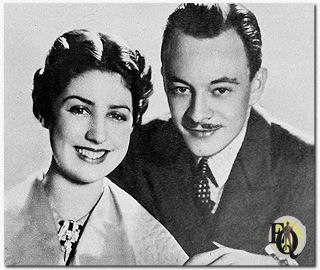 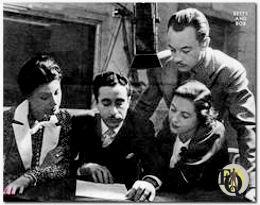 Above left: Betty and Bob - The stars if the first Gold Medal Hour serial, on CBS, are Elizabeth Reller and Lester Tremayne. Elizabeth is a graduate of London's Royal Academy of Dramatic Art, where she went to study after leaving college. Lester's really a Londoner, but came to America when he was a boy. He studied art but spent all the time he could working in theaters (1936). Above right: (L-R) Elizabeth Reller, Les Weinrott, Dorothy Shideler and Les Tremayne (standing) before the Betty and Bob microphone. |
|
| His first big break came in 1937, when he replaced (NBC-Red, 1932, as a lead from Jun 4. 1937 - mid 1943) Don Ameche as romantic lead, to Barbara Luddy, on the dramatic First Nighter Program. This was the show that whisked its listeners to New York City, to "the little theater off Times Square" where they would be treated to a fine "3-act play"... perhaps a romance... perhaps a tense drama... always intriguing and highly enjoyable. The show's introduction was a memorable one, encompassing the usual Broadway sounds: automobile horns blaring, people gathering together,.... The fact that the show emanated from Chicago was beside the point. All done in the most professional and believable manner imaginable. You were THERE! Since The First Nighter Program was not only heard but viewed by a live audience, Luddy and Tremayne appeared before their microphones elegantly attired in evening clothes... to foster the illusion of attendance at a prime play-opening.... and Tremayne's already-fine reputation soared! | |
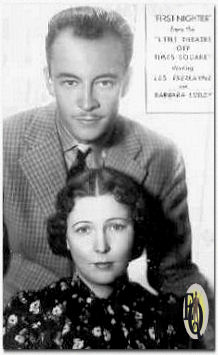 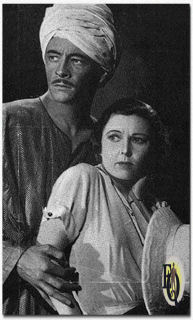 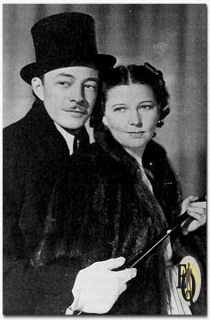 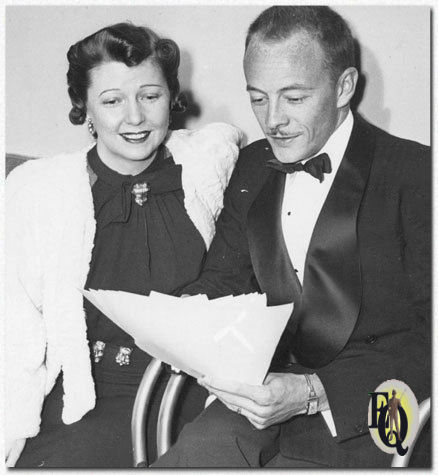 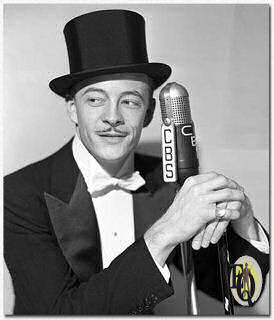 Top left: 1937 photo advertises performance of First Nighter at the Little Theatre off Times Square. Top middle: First Nighter play, "Three Men and a Message" (1939). Top right: Luddy and Tremayne appeared before their microphones elegantly attired in evening clothes... to foster the illusion of attendance at a prime play-opening. (1941) Above left: Barbara Luddy and Les Tremayne. Above right: Les Tremayne (1941) |
|
|
Les Tremayne, who was hospitalized in November 1937 due to a gunshot wound
sustained during target practice, found himself back there again one month
later following an automobile accident in which he wrecked a new car. He
suffered broken hands and cuts to his face. Another remarkable detail. In February 1938 Tremayne initiated steps to legalize his banking name to "Lester Tremmayne," with a double "m". The move was begun after Tremayne was recently victimized by an autograph seeker - who got the Tremayne signature on a check! The larcenous method was not new among stage and screen performers, but Tremayne's unhappy experience was probably the first in the history of radio. Tremayne started in television as early as 1939 in Chicago on W9XYZ, the Zenith experimental station. He was both playing hosting and playing the lead on a series of 45 minutes of dramatic shows. He quit after a few weeks. It took Les some time to overcome his first loss. A short article on October 11. 1939 reported the newest romance in Chicago radio circles: that of June Travis, of the Girl Alone cast, and Les Tremayne. However in May 1940 in Chicago, he married attractive actress Eileen Palmer. (2) |
|
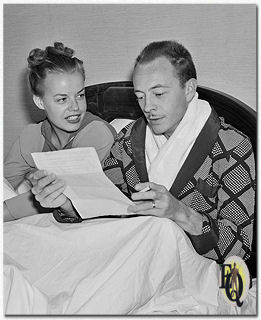 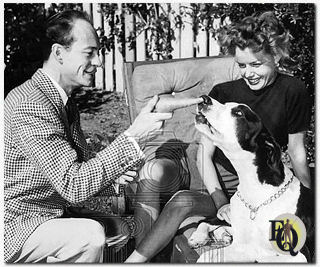 Above left: After getting married in May 1940, Les and his wife Eileen Palmer took a trip to Hollywood in August 1940. Eileen took on the role of Mrs. Benson in the soap opera The Life of Mary Sothern, and later appeared in Lone Journey and Lonely Woman. Above right: Carrot's Tops. And it has to be for "Thor," Les Tremayne's Great Dane, because the miniature horse, seen here with Les' wife (Eileen Palmer), is living a life of rationing, and we don't mean kennel rations. Tremayne is point out to "Thor" the benefits of carrots. "Thor" is just pointing. Les emcees Bob Crosby's show and has the horse to prove it. (NBC Photo, Nov 22. 1943) |
|
|
A poll in the early 1940s cited
Tremayne as one of the three most famous voices in America. The other
two were President Franklin D. Roosevelt and Bing Crosby. In 1943 Tremayne left Chicago for New York and then Los Angeles, where he enjoyed a lengthy career performing on virtually every type of radio show. There he starred with Bob Crosby on the Old Gold Show (1944) before serving in the military service. When the show moved to New York, he co-starred with a relatively unknown comic Jackie Gleason. New York proved to be very productive for Tremayne’s career. |
|
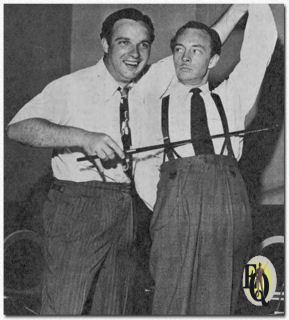 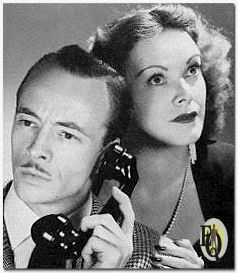 Above left: In Chicago Les starred with Bob Crosby on the Old Gold Show (1943) before serving in the military service. Seen here clownning behind the scenes, Tremayne is the fiddle. Above right: Publicity shot for Les Tremayne and Claudia Morgan, who played Nick and Nora Charles in The Thin Man on radio. |
|
|
Around September 1944 after just 4 years of marriage Les would divorce
Eileen Palmer. Shortly thereafter, on
December 11. 1945, Les remarried Alice Reinheart, herself a popular talented radio
actress. Due to the shortage of housing in New York, they were forced to
live in Alice's one-bedroom apartment at first. A solution that among
other things resulted in their dogs (Thor, the Great Dane, and Weaf, the
terrier), who didn't get along so well, staying in a kennel alternately.
Until they eventually found a larger apartment on Park Avenue in New
York City (1948). Their first vacation was one of many trips to Mexico, an interest they shared besides their passion for archaeology, for which they also took lessons. ** Les also had an extensive collection of camera equipment and was an amateur photographer. Moreover, he was also known as a talented sculptor, particularly for his masks. |
|
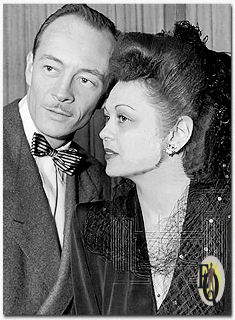 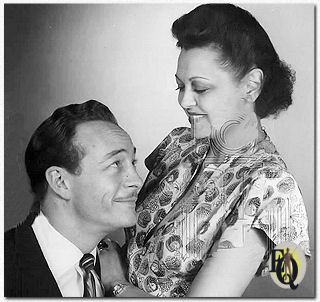 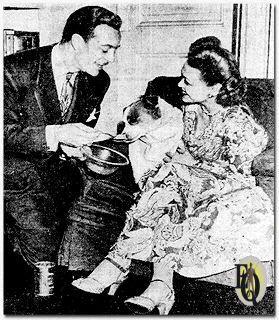 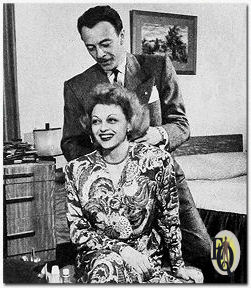 Top left: Wedding Bells coming up. Nuptials are in the offing for Les Tremayne and Alice Reinheart - names familiar to their legions of CBS listeners. Les is gentlemen detective Nick Charles in Adventures of the Thin Man on Sunday nights, while Alice is Chichi in Life Can Be Beautiful, five-a-week CBS serial. When they'll name the day depends on when some landlord names the day for them to move into a suitable apartment in home scarce New York (1945). Top right: Alice Reinheart (his 2nd wife) and Les Tremayne are MBS's detectives Pat and Jean Abbott in Abbott Mysteries. (1946 - 1947). Above left: Alice Reinheart and her husband Les Tremayne, claim their fox terrier Weaf is the smartest dog in town. "We have had to spell in front of him for a long time," Miss Reinheart says, "but now he is starting to correct our spelling." (Jan 1947) Above right: The apartment shortage kept the Tremaynes in one room until recently; that's why parties in their big new place are such fun. (1948) |
|
|
Throughout the
1940s, he was the voice of Nick Charles on the lighthearted mystery
series The Adventures of the Thin Man
(CBS, 1945 - 1946; NBC, Summer 1948). He also played detective Pat
Abbott (and his
wife played Jean Abbott) in Abbott Mysteries
(1946 - 1947)
and starred in the
mystery thriller The Falcon (1947 - 1949 -). It is estimated that Les worked on more than 30,000 broadcasts, with as many as 45 radio shows a week in the 1930s and '40s. "How I was able to attain whatever status I enjoy, with meager education and no powerful or influential friends to assist me, remains a mystery to me," he said in a 1991 interview. "Stubborn perseverance, I guess. Were it possible to live it over, I would change very little. I've been privileged to work in radio in the Golden Days. Nothing can top that." 1 Joyce Jordan, M.D. (N.B.C, 1947 - 1949 -); Wendy Warren & The News (CBS, 1947 - 1949 -) Readers Digest Program (Emcee, CBS, 1948); Hollywood Headlines (commentator, ABC, 1948), Cavalcade of Summer (1949); Walter Winchell Show (1949); Inner Sanctum (1949); Hall Mark Play House (CBS, 1949); Drew Pearson (ABC, 1949). |
|
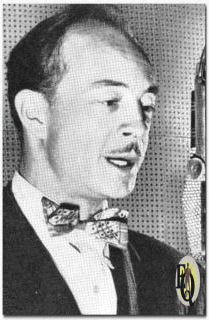 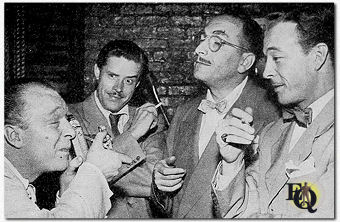 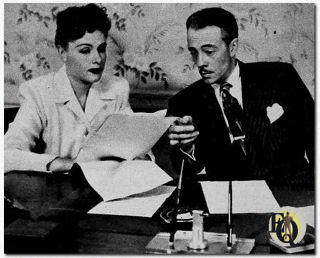 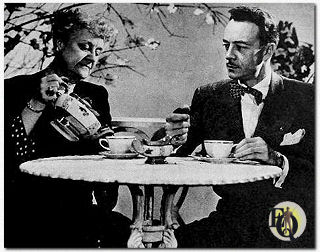 Top left: Publicity shot for Les Tremayne as The Falcon (ca. 1947). Top right: Casey, Crime Photographer (Staats Cotsworth) gets some other radio detectives to post for him. (L-R) Nick Carter (Lon Clark), Jeffrey Barnes (Bernard Lenrow) and Pat Abbott (Les Tremayne). (Jun 1947) Above left: Wendy Warren - on the air in 1947 with combination of story and news (Florence Freeman, Les Tremayne). Above right: Joyce Jordan, M.D.- Mrs. Iris Blakely (Elizabeth Watts) is wealthy, socially powerful, devoted to her attractive son Dawson (Les Tremayne). She bitterly resents the love between Dawson and Joyce, but knows she is indebted to Joyce's skill as a surgeon for Dawson's being able to walk. A recent plane crash had crippled Dawson, and there seemed no hope for him, until Joyce performed her magnificent operation (1948). |
|
|
His father passed away on December 6.
1948 in Marin, California and his mother remarried on September 14. 1949 in
Grand Ronde, Polk, Oregon to widower Charles Calvin Kinzer. That same
year Charles Jr. was born. He co-starred with second wife, equally beautiful radio actress Alice Reinhardt, on The Tremaynes breakfast talk show on WOR/New York (1949). After living in New York apartments for years, by 1952 they purchased a house perched atop one of the rare hills in the San Fernando Valley: the Sherman Oaks Hilltop estate on Davana Road. With white stucco, jauntily trimmed in blue, and surrounded by an acre of rich land on which persimmon and nut trees grew, along with lush green grass, various plants and bushes, and of course, a swimming pool. |
|
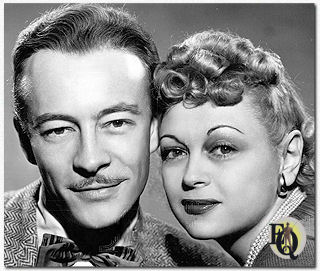 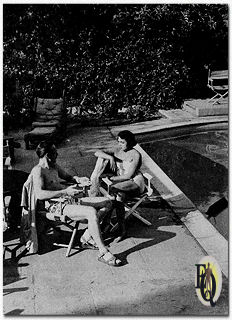 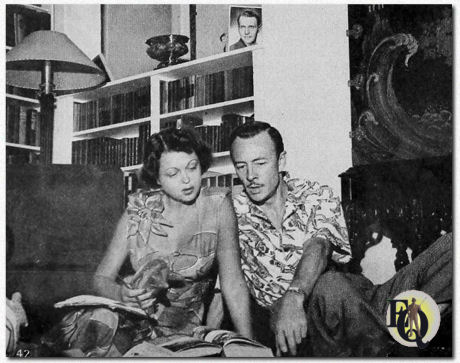 Top left: Teamed Mates: Les Tremayne and Alice Reinheart, husband and wife in real life, play the roles of Jeff and Virginia Carter, brother and sister, on NBC's new Carlton E. Morse daytime radio serial story of American family life, The Woman in My House (Apr 1951). Top right: All the big outdoors is theirs, now -and they are pleased! As the Tremaynes point out, who ever gets a swimming pool thrown in with the lease of a Manhattan apartment? (1952) Above: The secret of a successful marriage, say these two - who have one - is sharing. Les and Alice share both work and hobbies, foremost among the latter being archeology. (1952) (Note: notice the picture of Ralph Bellamy in the background) |
|

| After radio drama died, he moved easily into film and television work. So in the 1950s, he was a durable player in film and TV dramas. Typically playing shifty execs, errant husbands, and authoritative, no-nonsense professionals in teams of TV dramas, he appeared in numerous shows. Tremayne's credits read like a show business almanac: The Whistler (CBS, Apr 6. 1955), Perry Mason (CBS, 1958 - 1966), The Adventures of Rin Tin Tin (Screen Gems, 1958 - 1959), as Inspector Richard Queen in The Further Adventures of Ellery Queen (NBC, 1958 - 1959), The Rifleman (Four Star, 1959), Alfred Hitchcock Presents (NBC, 1960 - 1961), 77 Sunset Strip (Warner Bros., 1964), ... . All this along with a few sitcoms for good measure. |
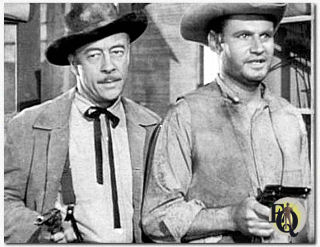 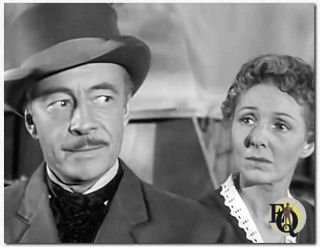 Above left: Les Tremayne and Adam Williams in "The Challenge" episode from The Riflemen (Four Star, Apr 7. 1959). Above right: Wagon Train (Universal, Apr 6. 1960) Les with Sylvia Marriott in the episode "The Maggie Hamilton Story". |
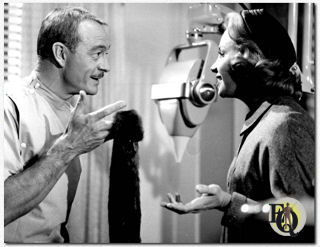 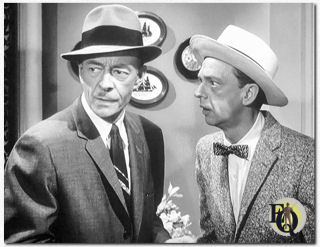 Above left: "Mrs. Bixby and the Colonel's Coat" an episode from the Alfred Hitchcock Presents series with Les Tremayne and Audrey Meadows. Audrey portrays a woman who gets an unexpected present from her dentist-husband, as played by Les Tremayne (NBC, Sep 27. 1960). Above right: "Andy and Barney in the Big City", an episode in the Andy Griffith series (Mayberry, Mar 26. 1962). |
|
Tremayne appeared in a number of
sci-fi and horror films during the 1950s and 60s. He played General Mann in the 1953 classic adaptation of H.G. Wells’ novel, The War of the Worlds (Paramount, Aug 26. 1953) co-starring Gene Barry and Ann Robinson. He also narrated the sci-fi classic Forbidden Planet (MGM, Jun 13. 1958). He starred in The Monolith Monsters (Universal, Dec 18. 1957), The Monster of Piedras Blancas (Vanwick, Sep 14. 1959), the original version of MGM’s special effects cult classic The Angry Red Planet (Sino, Nov 23. 1959) and the forgettable horror schlock film The Slime People (Donald J. Hansen, Sep 18. 1963) and again was the narrator for King Kong vs. Godzilla (Toho, Jun 26 1963). |
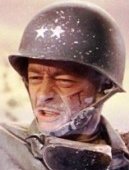
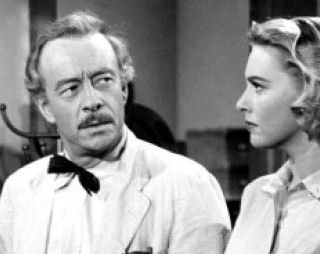
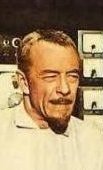 Above left: Tremayne as General Mann in the classic adaptation of H.G. Wells’ novel, The War of the Worlds. “Guns, tanks, bombs – they’re like toys against them!” (Paramount, Aug 26. 1953) Above middle: In The Monolith Monsters (Universal, Dec 18. 1957) Tremayne played a newspaper owner who looked and sounded like a lifelong resident of the desert community. Above right: Les Tremayne as Prof. Theodore Gettell in The Angry Red Planet (Sino, Nov 23. 1959). |
| He acted in other cinema genres as well. He co-starred with Irene Dunne and Richard Crenna in the comedy It Grows On Trees (Universal, Sep 2. 1952), and starred in the Maureen O’Hara comedy Everything But the Truth (Universal, Dec 1. 1956). Also among his movie roles, Tremayne played the auctioneer in Alfred Hitchcock's North by Northwest (MGM, Dec 18. 1959), he voiced a radio newsman in the James Bond film Goldfinger (Eon, Sep 20. 1964) and he had a small role in director Billy Wilder’s The Fortune Cookie (Mirish, Oct 19. 1966). |
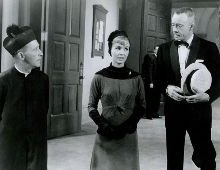
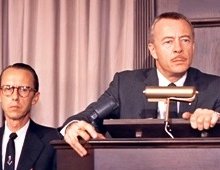 Above left: Bing Crosby, Debbie Reynolds & Les Tremayne in Say One for Me (Bing Crosby Productions, Jun 19. 1959) Above right: Olan Soule as Assistant Auctioneer and Les Tremayne as Auctioneer in North by Northwest (MGM, 1959) Back in 30s it was Olan who went on to do the First Nighter series which made Tremayne famous... |
|
On November 27. 1961 newspapers reported it was an unhappy holiday for Alice and Les. After 16 years of marriage they had decided that divorce was the only solution to their problems. Despite the fact that Alice was planning to resume her stage career in the East, those closest to them believed that between now and the final decree, the Tremaynes could reconcile. However this wasn't to be. Les remained in California, and on October 18. 1963, he remarried there to Ruth Ann Mills. Less than five years later, on May 26. 1967, their divorce was finalized. Both had filed for divorce on grounds of cruelty. Meanwhile, TV provided Les with a steady income through guest roles in many well-known series such as Bonanza (NBC, 1962 and 1970), The Beverly Hillbillies (Filmways-CBS, Dec 29. 1964), The Virginian (NBC-Universal, 1965 and 1966), ... |
 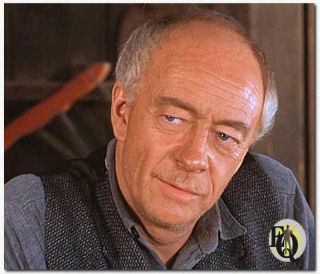 In The Virginian, a personable Western series based in Wyoming from the 1890s onward, Les made two guest appearances. Above left: As the clerk Mr. Lowell "A Slight Case of Charity" (NBC, Feb 10. 1965) Above right: As carpenter Horatio Troast in "An Echo of Thunder" (NBC, Oct 5. 1966). |
|
In 1966, Les was one of the founding members of the Pacific Pioneer Broadcasters, an organization made up of the individuals who participated in radio's glory days. Comic fans will probably best identify him for his role as Mentor on the 1974 - 1976 Saturday morning series, Shazam! But he also was heard on many cartoon shows. He was the Voice of Christmas Present in Mr. Magoo's Christmas Carol (NBC, Dec 18. 1962), the voice of Churchy LaFemme and other characters on The Pogo Birthday Special, (MGM-TV, May 18. 1969) and the villain in dozens of Hanna-Barbera shows. Professor Balthazar is a Yugoslav animated television series for children about an old inventor that was produced between 1967 and 1978. From 1971 to 1973, episodes were featured on the American ABC-TV children's program Curiosity Shop. The cartoon inventor was the basis for the show's puppet character, Baron Balthazar, and the cartoons were shown as animated sequences of the Baron's tales of his adventures and inventions back in "beautiful downtown Bosnia". The Professor was voiced by Les Tremayne. |
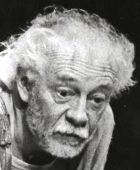
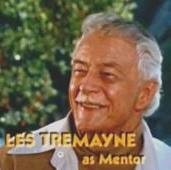
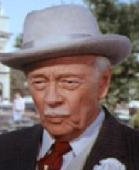 Above left: Les as the friendly, misunderstood eccentric psychopath Snakey in Fangs (aka Snakes) (Holy Wednesday Productions, Dec 1974). Above middle: Comic fans will probably best identify Les Tremayne for his role as Mentor on the 1974 - 1976 Saturday morning series, Shazam! Above right: Les Tremayne as Big Daddy Hogg in The Dukes of Hazzard (Lou Step, Warner Bros., Oct 29. 1982). |
|
On July 17, 1980, Les married for the fourth time to Joan L. Hertz in Riverside, Marion, Missouri. During the 80s - 90s he continued his streak of guest starring roles: The Dukes of Hazzard (Lou Step, Warner Bros., Oct 29. 1982), The 13 Ghosts of Scooby-Doo (Hanna-Barbera, 1985), as Edward Quartermain in General Hospital (ABC, 1987), Kid 'n' Play (Marvel-Saban, 1990), and The Pirates of Dark Water (Hanna-Barbera, 1991 - 1993),... In the mid-80's Tremayne co-produced and and co-hosted Please Stand By: A History of Radio... an accredited course of 30 half-hour programs... for a group of Southern California Community Colleges.3 It is documented that in various polls, he was voted the No. 1 dramatic actor in the highly popular commercial medium. Les Tremayne was inducted into the Radio Hall of Fame in 1995. He was a founding member of AFTRA radio performers union. He is reputed to have said that because of its reliability in delivering paychecks that radio helped an actor to be "......an upstanding, home-owning, stay-in-one-place, family-raising... good-credit-risk individual......." 3 |
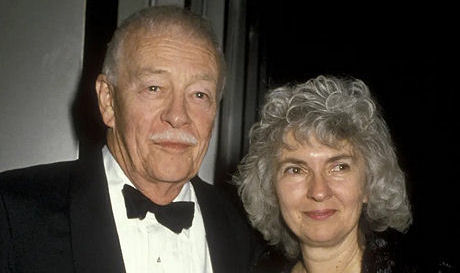 Above: Les Tremayne with his wife Joan in March 1986. |
|
In 2000 Les suffered a stroke and had lost his speaking voice. Fortunately, by later that year he had recovered, and the next three years were occupied with trying to write his memoirs. He and Joan had completed some 800 pages and had reached age five in les's life. It's unknown if Joan was able to complete the story. Tremayne stayed active in show business until his recent retirement. On December 19. 2003 he died of heart failure in Santa Monica, CA. He was survived by his wife, Joan, and half-brother, Charles Henning of Vermont. In 2009 he was portrayed by actor Michael Brandon in Me and Orson Welles (Freestyle Releasing, Mar 16. 2009). |
|
Notes: * In 1927, after a year in high school, Tremayne’s father forced him to quit and go to work. (Los Angeles Times, Dec 23. 2003) ** He was further educated at Northwestern University (Greek Drama, 1937 - 1939), Columbia (anthropology, 1949 - 1950) and UCLA (anthropology, 1950 - 1951). *** In later interviews, Les himself states 1931, while earlier sources peg it at 1932 (his nineteenth birthday). All dates for movies are for the first US release. All dates for TV programs are original first airdates. All dates for (radio) plays are for the time span the actor was involved. Facts in red still need confirmation. |
|
Click on Uncle Sam if you think you can help out...!
|
|
Other references
|
|
This actor profile is a part of
Ellery Queen a website on deduction.
The actor above played Richard Queen in
an
Ellery Queen TV series. Click Uncle Sam if you think you can help
out...! Many of the profiles on this site have been compiled after very careful research of various sources. Please quote and cite ethically! |
|
Page first published on January 1. 2013 Version x2.1 - Latest update April 23. 2025 |
 b
a c k
t o L i s t o f S u s p
e c t s
b
a c k
t o L i s t o f S u s p
e c t s
|
|
| Introduction | Floor Plan | Q.B.I. |
List of Suspects | Whodunit? | Q.E.D. | Kill as directed | New | Copyright Copyright © MCMXCIX-MMXXV Ellery Queen, a website on deduction. All rights reserved. |